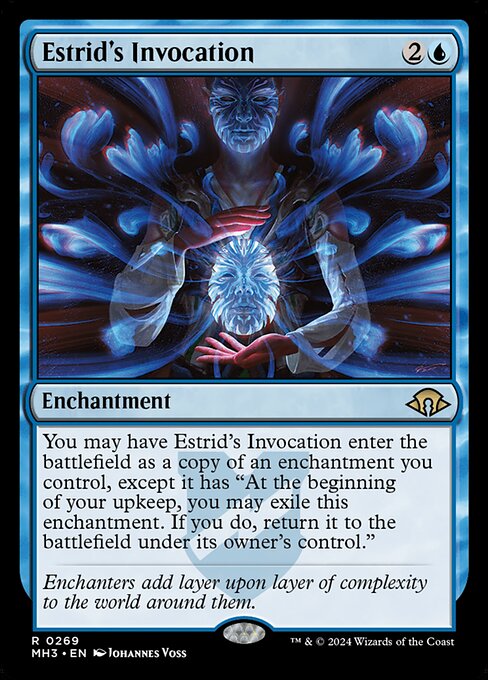
Image courtesy of Scryfall.com
Estrid's Invocation and the Enchantment Identity of Modern Horizons 3
If you’ve ever watched a match unfold where a blue mage keeps layering effects until the battlefield looks like a velvet-wrapped cathedral of memory, you’ve met the vibe Estrid’s Invocation embodies. This rare enchantment from Modern Horizons 3 (MH3) is a perfect lens for exploring how a set’s mechanical identity can echo its lore, its palette, and its playstyle philosophy. With a modest mana cost of {2}{U}, Estrid's Invocation enters the fray as a tasteful clone of an enchantment you already control, but it comes with a twist: a built-in upkeep exile that can return the enchantment to the battlefield under its owner’s control. In practice, this is blue wind and shadows weaving together to create layered, resilient engines. 🧙♂️🔥
MH3 itself is a draft-innovation set that leans into experimentation while laying a path for enchantments, artifacts, and clever copying to share a common stage. The artifact-heavy, spell-slinging blue archetype thrives on stacking utility and ensuring options never run dry. Estrid’s Invocation is a microcosm of that philosophy: it doesn’t demand you to cast new, flashy enchantments to shine; it invites you to copy what you already enjoy, then leverage the blink-like cadence of exile and return to extend your table-wide influence. This is the kind of design that rewards thoughtful deck-building and a keen eye for ongoing value. ⚡🎨
Layering through Copy: A Signature of Set Identity
The core effect—enter as a copy of an enchantment you control—turns Estrid's Invocation into a Swiss Army knife for enchantment-based decks. If you already own a staple like a reliable counterspell aura, an anthem that makes your board hum, or a fill-in enchantment that subtly tilts the game in your favor, Estrid’s Invocation can mirror that effect with a fresh timing window. This isn’t simply duplication; it’s strategic duplication that can interact with ETB triggers and static abilities in unpredictable, delightful ways. The set’s emphasis on enchantment synergies makes this approach feel organic rather than gimmicky; you’re weaving a tapestry of effects you’ve curated, and Estrid’s Invocation simply adds a mirrored thread. 🧩💎
Flavor-wise, the card’s flavor text line—“Enchanters add layer upon layer of complexity to the world around them.”—reads like a manifesto for MH3’s design ethos. The multi-layered enchantment identity is not just a flavor flourish; it’s a mechanical invitation to build complexity in a controlled, elegant manner. Estrid’s Invocation gives you permission to experiment with what you already own, while rewarding foresight and planful execution. It’s the kind of card that makes you grin when your counterplay becomes a counter-counterplay, all wearing the same blue cloak. ⚔️🌀
Upkeep Exile: A Quiet Engine Built on Timing
The exile-and-return clause is more than flavor; it’s a tempo engine. When you exile Estrid’s Invocation at the start of your upkeep, you’re choosing to reset its presence, potentially triggering enter-the-battlefield or copy-based lines of play anew when it returns. In multiplayer formats, this can look like a controlled repetition that pressures opponents to answer a dynamic board state while you maintain the advantage of options. It also creates an interesting interaction with other enchantments you control—if one of them is a perpetual engine, Estrid’s Invocation can serve as a surrogate “relic” that you retire and replay, letting you squeeze incremental value out of each upkeep phase. The set rewards that patient, puzzle-piece approach where timing and order matter as much as raw power. ⏳🎲
Design Echoes: Blue, Copying, and the Enchantment Ecosystem
In MH3, the blue identity often revolves around card advantage, counterplay, and ecosystem-building—copy effects are the lifeblood of that design space. Estrid’s Invocation is a compact blueprint for how a single card can influence a broader set identity: it encourages players to think in terms of layers, patterns, and synergies across enchantments rather than chasing big-name, one-shot plays. The rarity (rare) sits nicely with the card’s flexibility; it’s not a one-turn wonder but a recurring tool that can scale with your board state. And because it’s a reprint in MH3, it also nods to the set’s respect for the enchantment arc that has long been a fan favorite in the wider MTG ecosystem. The artwork by Johannes Voss complements the theme—an intricate, color-saturated vision that invites you to imagine the spells weaving through a hall of mirrors. 🪞🎨
Strategically, Estrid's Invocation shines in decks that lean into enchantment-themed engines—where the board presence depends on cascading, layered effects rather than singular power spikes. It’s a card that rewards patience and a well-curated toolbox: copy something you’ve already invested in, then lean into the interplay between your enchantments to outpace opponents who rely on haste and brute force. In that sense, the card is a meta-commentary on what MH3 is trying to achieve: a sense that the best plays unfold not just through raw mana curves, but through careful curator-like management of a growing, interconnected ecosystem. 🧙♂️⚙️
phone grip kickstand reusable adhesive holderMore from our network
- https://blog.digital-vault.xyz/blog/post/mastering-git-workflows-for-seamless-code-contributions/
- https://blog.digital-vault.xyz/blog/post/mite-overseer-classic-fantasy-art-homages-in-mtg/
- https://blog.digital-vault.xyz/blog/post/art-as-storytelling-vedalken-infuser-in-un-set-lore/
- https://blog.digital-vault.xyz/blog/post/malik-grim-manipulator-unhinged-humor-and-card-parody/
- https://crypto-acolytes.xyz/blog/post/how-crypto-empowers-indie-game-developers-to-thrive/